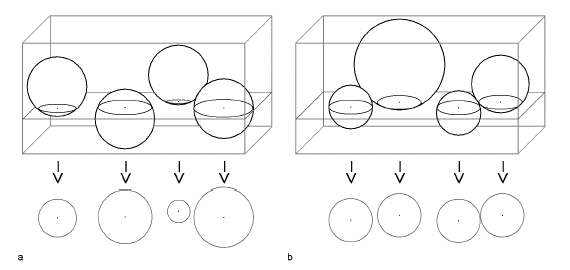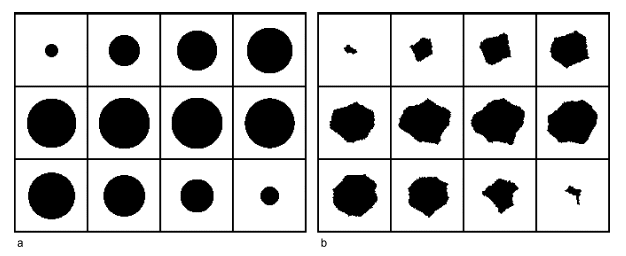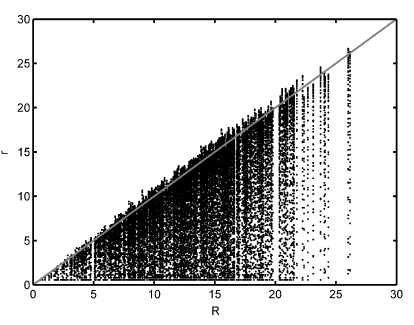|
Serial Sectioning |
|
Looking into a material: A very important step during the evaluation of the 3D grain growth simulation results is the comparison of the results with experimental data. Naturally the microstructure of a real material is a three-dimensional one but there are only few methods to ‘look into’ the material. However, especially the last years expanded the possibilities to examine 3D microstructures through the use of
The usually used method to get a deeper insight into a material’s microstructure is, still today, the serial sectioning. For this method the three-dimensional specimen is cut into a series of two-dimensional sections. These sections can either be evaluated directly or put back together to a three-dimensional microstructure with the help of a computer program and then be evaluated. The problems that come along with this method are long known and have been investigated for years [Underwood (1970); Russ and Dehoff (2001); Ralph et al. (2006)]; see also [Zöllner and Streitenberger (2007); Zöllner (2006)]. Single grains: If we consider for reasons of simplification at first an ensemble of equally sized randomly distributed spheres we can see easily (Figure 1a) that a random section yields circles of different sizes which does not mirror the 3D size distribution. On the other hand if we take an ensemble of non-equally sized randomly distributed spheres a random section may result in equally sized 2D circles (Figure 1b).  Figure 1: a - Ensemble of equally sized randomly distributed spheres together with a random section yielding circles of different sizes; b - Ensemble of non-equally sized randomly distributed spheres together with a random section resulting in equally sized 2D circles. Coming now to a real microstructure we can also say that equally sized 2D grain sections do not have to have the same 3D size and non-equally sized 2D grain sections could have the same 3D size. In order to understand this problem a little better we should have a look at the sectioning of a sphere and a grain. The latter one is taken out of a 3D grain structure simulated with the Monte Carlo Potts model algorithm. Figure 2 shows some sections through the sphere and the grain. One can see that for both the size first increases with increasing distance, reaches a maximum and then decreases again until it finally disappears. Therewith the section through a sphere always yields a circle only with different radii depending on the place (distance) of the sectioning. On the other hand the form of the sections of the grain depends strongly on the distance and on the orientation of the sectioning.  Figure 2: Equally distanced sections through: a - a sphere; b - a grain. It can be understood easily that the real radius R of the sphere can only be found in the section through the centre of the sphere. All other parallel sections yield a smaller value for the radius. Furthermore, this relationship does not depend on the direction of the section. It is furthermore easy to see that the radius R of a grain defined as the radius of a volume-equivalent sphere does not need to be found in a section at all because a grain is not a sphere and its sections are therefore no circles but rather polyhedrons with slightly curved boundaries (cf. Figure 2), which are only approximated as circles for the calculation in the same way the whole grain is approximated as a sphere. Grain ensemble: In order to evaluate not only single grains but a grain ensemble we will compare in the following the size of 2D sections and 3D ensemble data taken from the Monte Carlo Potts model simulation. Therefore, a time step, namely the 500th, out of the quasi-stationary self-similar coarsening regime has been selected. For a randomly picked simulation run the 3D lattice has been sectioned into parallel planes.  Figure 3: Relation between the radii of all grains in the 2D sections and the radii of the 3D ensemble. If we consider the relation between the radii r of all grains in the 2D sections and the radii R of the 3D ensemble and take the knowledge about the sectioning of single grains into account we know that to each grain with radius R will belong more than one section with radius r with a maximum value that is approximately as large as R. This relation is given in Figure 3. One can see that indeed most simulation data lie below the function r = R. The vertical arrangement of the simulation data originates in the fact that a single grain has only one radius R calculated from its volume but more than one section each with a radius r. The lower cut-off in the grain size of the 2D sections originates in the minimal grain size, which is equal to one lattice point respectively Monte Carlo Unit with a minimal area of 1. |
| [Holm and Duxbury (2006)] | E.A. Holm and P.M. Duxbury. Three-dimensional materials science. Scripta Materialia, 54:1035, 2006. |
| [Underwood (1970)] | E.E. Underwood. Quantitative Stereology. Addison Wesley, Boston, 1970. |
| [Russ and Dehoff (2001)] | J.C. Russ and R.T. Dehoff. Practical Stereology. Kluwer Academic/Plenum Publishers, 2001. |
| [Ralph et al. (2006)] | B. Ralph, L. Wojnar, K.J. Kurzydlowski, and J. Cwajna. 9th ECSIA and 7th STERMAT: Stereology and image analysis in materials science. Materials Characterization, 56:256, 2006. |
| [D. Zöllner and P. Streitenberger (2007)] | D. Zöllner and P. Streitenberger. New analytical grain size distribution in comparison with computer simulated and experimental data. In: Fortschritte in der Metallographie, Edited by F. Mücklich, Praktische Metallographie Sonderband 39, Werkstoff-Informationsgesellschaft mbH, p. 97-102, 2007. |
| [Zöllner (2006)] | D. Zöllner. Monte Carlo Potts Model Simulation and Statistical Mean-Field Theory of Normal Grain Growth. Shaker-Verlag, Aachen, 2006. |
Datenschutzerklärung der Otto-von-Guericke-Universität Magdeburg nach DSGVO